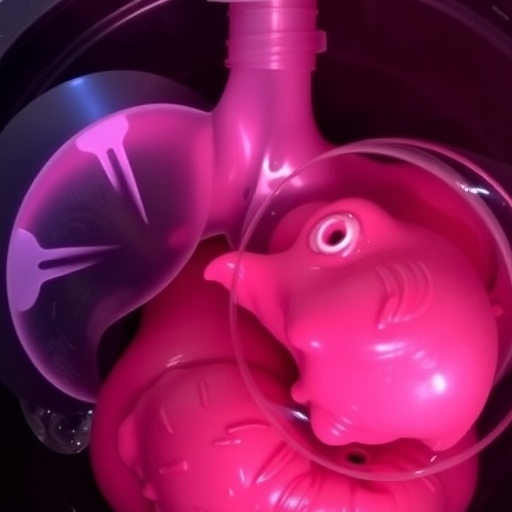In a groundbreaking exploration into the complexities of fetal conditions, a recent study sheds light on a phenomenon termed “faulty fetal packing.” At the core of this research lies an extensive examination of clinical cases that underscores the medical community’s need to better understand this apparent anomaly. As advances in prenatal imaging technology reveal new details about fetal development, these findings are particularly significant for obstetricians and pediatric radiologists alike.
This innovative work, spearheaded by researchers including Noda, Otjen, and Koti, dives into the intricacies of how packing issues affect fetal positioning and development. While previous literature has briefly touched upon similar subjects, this case series pairs clinical observations with aesthetic and anatomical analyses that could transform clinical practices. It raises important questions about how these anomalies might be detected earlier in pregnancy and their implications for both mother and child.
Faulty fetal packing is characterized by abnormal distributions of fetal components during gestation. The phenomenon can lead to serious complications during delivery, including the risk of obstructed labor or even emergency cesarean sections. It stands in stark contrast to conventional understanding of fetal positioning, which generally portrays a clear and orderly arrangement. The consequences of such packing issues extend beyond labor and delivery, potentially impacting long-term outcomes for the child.
Through comprehensive literature review, the authors emphasize a need for heightened awareness among healthcare providers. They argue that recognizing faulty fetal packing during prenatal scans can lead to timely interventions that can save lives. The study highlights several cases wherein failure to identify abnormal packing resulted in unexpected complications during childbirth. These anomalies bring to light the importance of distinguishing between typical variations in fetal positioning and those that signal underlying problems.
One of the most striking aspects of this research is the diversity of cases examined. Ranging from subtle positioning variations to extreme examples of compromised fetal arrangement, the authors meticulously document the clinical challenges posed in each instance. Each case is not just a unique story but offers critical lessons on the necessary vigilance healthcare practitioners must adopt when assessing fetal development.
Technological advancements in imaging, including 3D ultrasound and MRI, play a pivotal role in identifying fetal packing issues that might remain hidden through standard 2D imaging techniques. The authors point out that an enhanced understanding of the anatomical layout can provide practitioners the tools to make informed decisions regarding delivery methods and postnatal care. These tools not only improve real-time diagnostics but also allow for long-term tracking of associated risks.
In discussing the clinical implications, the authors advocate for a multidisciplinary approach involving obstetricians, pediatricians, and radiologists. They emphasize that a collaborative strategy can streamline communication and enhance outcomes for mothers and infants alike. This strategy is not merely about sharing information; it’s about fostering an environment where all healthcare professionals are seasoned on the nuances of fetal development and potential complications.
Another vital component of the study relates to the qualitative assessments of risk associated with faulty fetal packing. The research illustrates how variations in fetal positioning can correlate with certain congenital anomalies, which are often overlooked during routine examinations. This correlation highlights the pressing need for clinicians to be well-versed in the implications of fetal arrangements and the significance of thorough investigations when abnormalities are suspected.
Moreover, the emotional element cannot be overlooked. Expecting parents often place immense trust in their healthcare providers to ensure a smooth pregnancy and delivery experience. When complications arise from undiagnosed packing issues, the impact can be profound, not only physically but also psychologically. The authors call for increased empathy and communication between providers and families, which can help mitigate fears associated with perceived risks.
The study further explores the ethical dimensions of fetal imaging and intervention. As prenatal technologies advance, the potential for detecting complex issues before birth becomes a double-edged sword. While early diagnosis offers opportunities for management, it also raises questions about the extent of intervention and the choices that expectant parents must make. This highlights an ongoing dialogue in medicine, wrestling with the balance between necessary clinical intervention and respect for parental autonomy.
In summary, this profound research presented in the Pediatrics Radiology journal serves as a crucial reminder of the complexities woven into the narrative of prenatal care. As healthcare providers grapple with understanding the implications of various fetal arrangements, the collective goal remains clear: to improve maternal and infant health through knowledge, vigilance, and compassion.
Every discovery in this field also lays the groundwork for future studies. It opens doors to inquiries about genetic and environmental factors that might contribute to these anomalies. Clearly, as we push the boundaries of our understanding of fetal development, we must also consider the implications on healthcare practices and the nurturing of healthier families.
Thus, the work of Noda et al. stands not only as a clinical examination of faulty fetal packing but also as a beacon guiding future research. A better understanding today can pave the way for safer deliveries and healthier children tomorrow.
Ultimately, this research may act as a call to action for practitioners to refine their diagnostics and explore innovative solutions to improve outcomes. An interdisciplinary approach can only enhance our collective understanding of these complex issues, ultimately ensuring that current and future generations benefit from advancements in prenatal care.
Subject of Research: Faulty fetal packing and its implications in prenatal care
Article Title: Faulty fetal packing: a case series and literature review
Article References:
Noda, S.M., Otjen, J., Koti, A.S. et al. Faulty fetal packing: a case series and literature review.
Pediatr Radiol (2025). https://doi.org/10.1007/s00247-025-06318-y
Image Credits: AI Generated
DOI: https://doi.org/10.1007/s00247-025-06318-y
Keywords: fetal packing, prenatal care, obstetric complications, imaging technology, maternal health, interdisciplinary approach, congenital anomalies, pregnancy assessment, fetal development, prenatal interventions.




